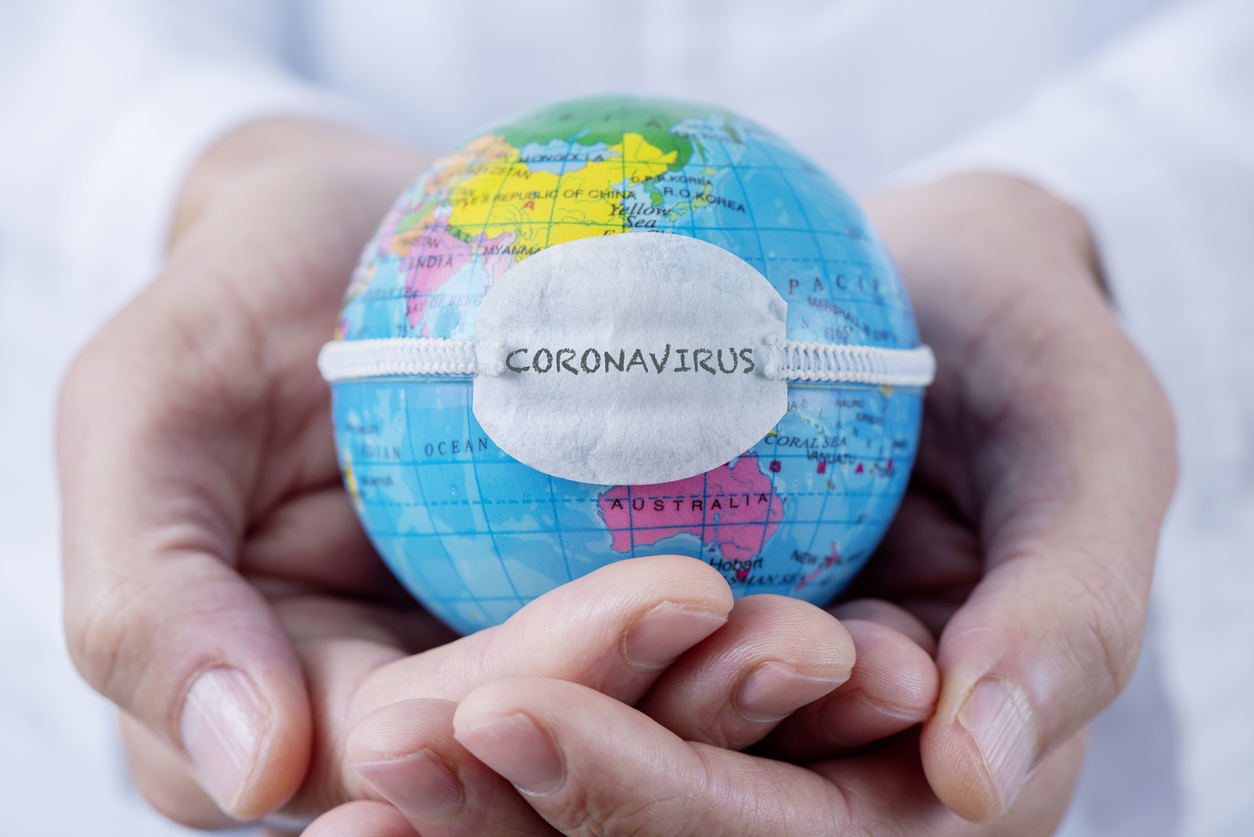
The string of record-breaking weather events and emergence of new diseases with time shows clealry that we do not have the luxury of ‘waiting this out. Despite progress made by many countries in devising more robust systems of early warning and responsive protection, which have led to far fewer people deaths resulting from natural disasters. the COVID-19 pandemic has demonstrated that almost without exception, countries around the world are still ill-prepared to deal with multiple overlapping crises, which often cascade, with one triggering another. Significant economic losses have also resulted from the “triple threat” of disease, disaster and climate change.
The annual average of disaster-related losses currently stands at $780 billion, which could nearly double, to around $1.4 trillion, in a worst-case climate scenario. At an annual cost of $270 billion, choosing a proactive strategy of adapting to natural and other biological hazards would be far more cost-effective.Fast facts: Coronavirus and COVID-19
The coronavirus, SARS-CoV-2, was first identified on December 31, 2019.
The World Health Organization (WHO) declared the outbreak a public health
emergency of international concern on January 30, 2020. The WHO later declared
a pandemic, meaning it is spreading globally, on March 11, 2020.
COVID-19 is the first pandemic since the 2009 swine flu (H1N1) pandemic. Unlike
COVID-19, H1N1 mostly affected children and young adults.
The COVID-19 pandemic pushed an additional 163 million people into extreme
poverty by 2021, according to World Bank estimates.
Experts estimate that the pandemic added an additional 118 to 161 million people
to the ranks of the undernourished in 2020.
More than 90% of the global student population has been affected by coronavirus-
related school closures. And only 12% of households in least developed countries
have internet access at home.
More than 11 billion vaccine doses have been administered around the world,
including in the United States
What’s the latest update on COVID-19 vaccines and booster shots?
Drugmakers around the world raced to find safe and effective vaccines against the
coronavirus disease. The U.S. Food and Drug Administration (FDA) has authorized three
COVID-19 vaccines for emergency use during the coronavirus pandemic: Pfizer-
BioNTech, Moderna, and Johnson & Johnson. Pfizer-BioNTech received full FDA
approval for individuals 16 years and older on August 23, 2021.
Booster shots refer to an extra dose of a vaccine after the original dose is administered.
Boosters are developed to help people maintain their level of immunity for longer. The
CDC and FDA approved booster shots for the Pfizer vaccine on September 22,
2021. The FDA later approved booster shots for the Moderna vaccine on October 20,
2021. Then on November 19, 2021, the FDA approved additional action and expanded
the use of COVID-19 booster shots for everyone 18 and older.
Regarding vaccines for children, the FDA expanded the use of Pfizer’s COVID-19
vaccine for kids as young as 12 on May 10, 2021. Then on November 2, 2021, the CDC
advisory panel voted unanimously to authorize emergency approval for Pfizer’s COVID-
19 vaccine for children ages 5 to 11. The CDC lists its recommendations on COVID-19
vaccines for children and teens here.The availability of COVID-19 vaccines for vulnerable people globally will enormously
benefit the hundreds of millions of children who’ve been negatively impacted by the
pandemic, by giving them a lifeline to return to their childhoods. Vaccines are a game
changer for children, as they allow kids to resume school and families to recover their
livelihoods.
As a global and local staff, World Vision has extensive experience confronting
pandemics, supporting vaccination programs, and improving child health. We’re working,
alongside our partners, to implement immunization campaigns and ensure communities
understand the benefits of a COVID-19 vaccination.
Resistance against crisis
COVID-19 has caused significant disturbances at all societal levels. The impacts range
from national lockdowns to social distancing and self-isolation. Everyday practices and
business processes are severed or have been halted. Resilience is needed. But how can
we foster resilience in the face of a pandemic? What lessons can we learn from other
crises like natural disasters? The purpose of this brief communication is to identify
important insights from a study of the Great East Japan Earthquake of 2011 and illustrate
how they are relevant to the current crisis. We identify the role of information systems in
fostering resilience against crisis, and suggest some recommendations regarding
transformation for resilience more generally.Natural disasters can throw societies into a crisis. On one hand, crises related to natural
disasters, such as earthquakes and tsunami, cause powerful but short-term impacts that
need immediate intervention; for example, the physical destruction of living and working
places; issues related to access and mobility; and health-related problems. Elsewhere,
we have discussed the issues surrounding the restoration of workplaces after a natural
disaster. On the other hand, crises like climate change and pandemics require long-term
intervention. The impact of increased flooding, sea level rises, heavy rain and drought
affects social conditions. An ultimate goal of long-term intervention is to mitigate potential
risks or the vulnerability of geographical, physical infrastructure and social components,
thus taking steps towards a more sustainable society. In any crisis, socially and
ecologically resilient systems are required to restore order. Natural disasters comprise
complex ecological problems and lead to novel societal issues. Often they require new
and innovative solutions. Expected solutions are different as situations, damages and
people’s needs are unique owing to the local context.
Natural disasters expose the weakest points in people, communities and social
infrastructures. A crisis reveals the weak connections among key stakeholders. These
include issues related to information sharing, vulnerable communities such as the elderly
and expectant mothers, and ageing infrastructures. We observe the same types of issues
in the current COVID-19 situation. Following a natural disaster, many of us are forced to
change our everyday and work practices. As of the time of writing, in most affected parts
of the world, there is confusion and no consensus over when and how to move from a
lockdown state to a post-COVID-19 world. Both mitigation of the short-term impact andlong-term intervention are necessary to maintain social functions and begin a transition to
smooth recovery.
While the novel Coronavirus presents new health challenges, the challenges associated
with the controlling of pandemics and the effective use and management of technology in
crises are not entirely new. One problem is that some scholars dismiss the role of
information systems as hype. This is a dangerous attitude, which must be changed.
Pioneers in our field have been raising red flags for a while. For example, in a series of
articles addressing the need to focus on technological solutions to prepare for the next
wave of pandemics, reminded the scientific community that “good technology and
training have not been available and there are no clear rules regarding making data
accessible. We agree with Gates but go further to suggest that good resilient technology
is needed. To that end, resilient thinking based approaches to research are required.
An important question to consider is: how can we improve established IS theories and
frameworks to include resilience? Based on our reflections and lessons learnt from the
empirical case, we offer some specific recommendations for the scholarship and all
stakeholders involved in the management of COVID-19 and future pandemics. Our hope
is that these recommendations will provide some insight into how we can transform for
resilience
Crises are a test of resilience because they affect society in unforeseen ways. COVID-19
shows that resilience needs to be fostered in all parts of society. A crisis like COVID-19
challenges our preoccupation with business and commerce issues, such as tasks,
efficiency, performance and money, and forces us to reflect on the commerce of
everyday life and human values, i.e. what matters and how technologies can be used for
good. We should avail of this opportunity and reflect on the fundamental challenges
facing society. Interdisciplinary approaches should be developed to build bridges that
facilitate the flow of knowledge to and from diverse areas. Some fifteen years ago, called
for “developing academic expertise in the areas of epidemiology” in order to effectively
use technology in the management of crises (p. 414). Her call remains mostly
unanswered. Hence, we are compelled to conclude on a similar call. There is a severe
lack of studies on pandemics and epidemics in the IS literature. Digital technology should
be used in a productive and ethical way to develop long-term resilience in society. Much
more effort is required to bring information technology to the centre of contemporary
debates on resilience and crisis.
Recovery is possible
It would be unwise not to recognize the lessons that can be gained from other disaster
and post-disaster contexts. In this brief document, we highlight key insights from research
on other crisis situations that we hope can inform recovery from the impacts of COVID-19
as well as the management of responses to future pandemics.
The main concern in this document is how to manage the long-term implications of the
pandemic in lower and middle-income countries (LMICs), because of the combination ofmore widespread poverty and structurally weaker support capacity within many of those
countries. However, the lessons are by no means restricted to those contexts.
Central in the arguments is the importance of supporting people to recover their
livelihoods and wellbeing, quitably and sustainably. As in all disasters, there are much
greater numbers of people affected by the crisis than physically harmed by the hazard (in
this case a biological hazard – the outbreak of a virus). And, as in all disasters, these
impacts do not fall evenly. Hence, the lessons we report on are oriented to the needs and
concerns of those most vulnerable to long-term impacts, as shaped by differential
exposure to hazards and barriers to recovery associated with poverty, marginalization,
and exclusion. The aim is to promote longer-term, integrated thinking, and planning, to
create pathways out of the pandemic that more effectively supports recovery.
The following pages cover eight inter-related lessons from the research work in Latin
America, the Caribbean, East Africa, and South Asia, which were organized into four
main sections: Managing a prolonged crisis; Planning for complexity; Establishing
priorities for recovery; and Building capacities.
Ground Reality
Cast your mind back a few weeks and imagine someone telling you the following: within a
month, schools will be closed. Almost all public gatherings will be cancelled. Hundreds of
millions of people around the world will be out of work. Governments will be throwing
together some of the largest economic stimulus packages in history. In certain places,landlords will not be collecting rent, or banks collecting mortgage payments, and the
homeless will be allowed to stay in hotels free of charge. Experiments will be underway in
the direct government provision of basic income. Large swathes of the world will be
collaborating – with various degrees of coercion and nudging – on a shared project of
keeping at least two metres between each other whenever possible. Would you have
believed what you were hearing?
It’s not just the size and speed of what is happening that’s dizzying. It’s the fact that we
have grown accustomed to hearing that democracies are incapable of making big moves
like this quickly, or at all. But here we are. Any glance at history reveals that crises and
disasters have continually set the stage for change, often for the better.
But disasters and emergencies do not just throw light on the world as it is. They also rip
open the fabric of normality. Through the hole that opens up, we glimpse possibilities of
other worlds. Some thinkers who study disasters focus more on all that might go wrong.
Others are more optimistic, framing crises not just in terms of what is lost but also what
might be gained. Every disaster is different, of course, and it’s never just one or the other:
loss and gain always coexist. Only in hindsight will the contours of the new world we’re
entering become clear.
Pandemics are a perfect example of the kind of crises to which global capitalism (with its
constant movement of people and goods) is particularly vulnerable, but that the capitalist
mindset (with its inability to think in terms beyond profit) cannot address. “In a rational
world, we would be ramping up production of basic essential supplies – test kits, masks,
and respirators – not only for our own use, but for poorer countries, too. Because it’s all
one battle. But it’s not necessarily a rational world. So there could be a lot of
demonization and calls for isolation. Which will mean more deaths and more suffering
worldwide.”
For years, in mainstream politics the conventional line – on everything from healthcare to
basic living expenses such as housing – has been that even if the world has its problems,
expansive government intervention is not a feasible solution. Instead, we have been told
that what works best are “marketplace” solutions, which give large roles to corporations
motivated not by outdated notions like “the public good” but by a desire to make a profit.
But then the virus started spreading, governments spent trillions in days – even going so
far as to write cheques directly to citizens – and suddenly the question of what was
feasible felt different.
From this perspective, the task today is not to fight the virus in order to return to business
as usual, because business as usual was already a disaster. The goal, instead, is to fight
the virus – and in doing so transform business as usual into something more humane and
secure
The impact of the COVID-19 pandemic may be particularly severe, resulting in acute
exacerbations of chronic food insecurity, inadequate access to health care, and ongoing
human rights abuses It is also anticipated that the pandemic will disrupt routine childhood
vaccinations, restrict educational opportunities, and lead to further economic deprivationamong populations who already face severe poverty. These disruptions make it likely that
COVID-19 could reverse some of the humanitarian and development gains made in
recent years.
COVID-19 related restrictions are already impacting global food supplies as well as the
availability and affordability of safe and nutritious foods. The UN World Food Programme
predicts that by the end of 2020, COVID-19 could double the number of people facing
acute food insecurity, with the majority of those living in conflict-affected countries.
Transportation and economic restrictions, export bans and border closures, job loss-
related diminished purchasing power, and threatened agricultural production will all
contribute to increased food insecurity. Malnutrition, worsened by food insecurity, will
further increase the risk of contracting not only COVID-19, but also other infections such
as measles, pneumonia, malaria and diarrheal illness, particularly among younger
children.
The Real Challenge yet to come
Health care response to the COVID-19 pandemic will need to be coordinated with
existing programs and system-strengthening initiatives in order to meet both pre-existing-
and pandemic-related needs. It is critical that systems be inclusive of the most vulnerable
populations, including IDPs, refugees, and other marginalized groups. Evidence from
past epidemics demonstrates that outbreak containment diverts resources from routine
health services, including maternal care, treatment of other diseases, and immunization
programmes. Routine immunization services have already been disrupted or halted in
53% of countries, affecting approximately 80 million children under the age of 1 year. In
countries supported by the Global Alliance for Vaccines and Immunizations, over 24
million people are at risk of missing critical vaccinations such as measles, cholera, polio,
typhoid, rotavirus, and meningitis. This is particularly worrisome since the overcrowded
living conditions and lack of adequate WASH can exacerbate rapid spread of these highly
communicable illnesses. Furthermore, concerns have been raised over equitable access
to COVID-19 vaccines when they do become available. Access to COVID-19 vaccination
in CHE settings will require affordable access and distribution to those most in need,
rather than those most able to pay. The global competition observed for COVID-19 tests
and PPE is likely to be even fiercer for vaccination. With declining funding and limited
ability to advocate for themselves in the global market, people affected by CHEs are at
risk of being neglected when COVID-19 vaccines are eventually distributed.
Sustaining and improving health care and public health systems will also require
increased funding at a time when many donor nations are facing their own economic
challenges. In northern Yemen, major donors began to reduce or suspend aid as the
pandemic began, just as additional support was most needed. With so few health care
providers in DRC, Yemen and Cox’s Bazar at baseline, should a proportion of the
workforce be unable to work due to COVID-19 infection, the strain on already limited
health care systems could be overwhelming.On March 23, 2020, the UN Secretary-General called for a global ceasefire to allow
humanitarian assistance in light of the COVID-19 pandemic. Despite this potential
opportunity to move peace agendas forward and in the midst of urgent calls for the UN
Security Council to address COVID-19 as a threat to global peace and security, conflict
and insecurity continues in many areas. In Yemen, all parties to the conflict have
continued fighting, with resultant civilian casualties and loss of infrastructure. Blame for
spreading COVID-19 is also escalating tensions, and the pandemic is being used as a
recruitment opportunity in Yemen, where Houthi activists are using the media to tell
potential recruits that, “it is better to die a martyr in heroic battles than dying at home from
the coronavirus.” There is further concern that human rights abuses are being committed
under the guise of pandemic response. For instance, in Yemen, some migrants are facing
discrimination as disease carriers, resulting in physical and verbal harassment, denial of
health care, and forced quarantine without food, water, or other essential services. There
is additional worry that rates of sexual and gender-based violence are increasing as a
result of COVID-19, highlighting the unique ways in which women and girls are affected
by the pandemic, and how these can increase vulnerability to violence. While the
pandemic could serve as a turning point for cooperation and advancement of peace
agendas, early days suggest that COVID-19 will be more likely to destabilize, thereby
compromising supply chains, health care provision, social structure, and economic
markets – all of which will ultimately increase civilian suffering.
It has been observed that still many children unable to access formal education. Now,
due to the pandemic, schools have been closed in more than 160 countries, affecting 1.5
billion children and youth. With disrupted education for 80% of students globally, loss of
learning is especially concerning in light of further human capital loss and reduced
economic opportunities in the long term. As the Ebola outbreaks demonstrated, theimpact of lost education often has the most devastating consequences in countries where
educational access is already challenging, and where school dropout rates are high.
From a workforce perspective, although younger populations are believed to experience
less morbidity from COVID-19, patients experiencing severe COVID-19-related illness
and death in Yemen appear to be younger than those seen earlier in the pandemic in
Europe. Similarly, early reports from Brazil, Mexico, and India showed increased mortality
among younger populations. Higher infection rates and more severe illness among
younger patients has the potential to affect the future workforce, potentially exacerbating
the economic burden of COVID-19. Although COVID-19 is expected to decrease the
global gross domestic product (GDP) by 1.9% in 2020, these effects will be felt unevenly.
Many people survive on small daily earnings, and will be unable to adhere to COVID-19
imposed restrictions without a total loss of income. Already facing considerable poverty,
even a small reduction in income for those living in CHEs may have significant impacts –
reducing access to food, health care, WASH, and other essential supplies.
The pandemic also has the potential to create positive impacts for few populations. Digital
innovations may find new ways to support lower class, such as the first-ever virtual
reproductive health training conducted in many parts of the world. Social welfare
programs may be increased, as was the case in more than 190 countries. The
humanitarian sector has been working to move away from programs run by an ever-
changing rotation of expatriates, and COVID-19 travel restrictions could encourage more
roles to be taken up by local citizens and displaced populations themselves.
COVID-19 will additionally impact humanitarian responders. For example, an April 2020
survey found that almost all humanitarian operations had been impacted by the
pandemic, yet only a small number were stopped completely. Furthermore, there have
been reports of backlash against both international and national staff as vectors for the
virus. Anecdotally, many responders also face difficulties related to travel restrictions andquarantine rules when entering a new country or returning home, as well as a responsibility to respond to the pandemic in their own country, all of which make it more difficult to respond in international settings.
It is important to note that, with the WHO having just declared COVID-19 a global pandemic in March 2020 (at this writing, less than five months ago), it is still relatively early in what is expected to be a prolonged pandemic.
 Pride News Daily NEWS
Pride News Daily NEWS





